Why Data Driven Decision Making is Your Path To Business Success

Table of Contents
1) What Is Data Driven Decision Making?
2) Why Is Data Driven Decision Making Is Important?
3) Successful Data Driven Decision Making Examples
4) Tips For An Enhanced Decision Making Strategy
We read about it everywhere. The term ‘big data’ alone has become something of a buzzword in recent times – and for good reason.
By leveraging the wealth of digital insights available at your fingertips and embracing the power of business intelligence, you can make informed decisions with confidence - the kind that will lead to commercial growth, evolution, and a healthier bottom line.
By implementing the right reporting tools and understanding how to analyze as well as measure your data accurately, you will be able to perform the kind of decisions that will drive your business forward. Of course, this sounds incredible in theory.
But in practice, even if you have access to the world’s greatest data, it’s possible to make decisions that disregard tangible insight, going with your gut instead. In most cases, this can prove detrimental to the business.
While sometimes it’s okay to follow your instincts, the vast majority of your business decisions should be backed by razor-sharp metrics, facts, figures, or insights related to your aims, goals, or initiatives that can ensure a stable backbone to your management reports and business operations. Data based decision making will propel your business to new heights while making it more adaptable to an ever-changing commercial landscape. It should be at the heart of all of your strategies, activities, and operations.
To help you on your quest towards analytical enlightenment, we’re going to explore DDDM, study the importance of data driven decisions, consider the benefits of developing a data driven culture, and examine some real-world examples of turning insight into business-boosting action.
What Is Data Driven Decision Making?
Data driven decision making (DDDM) is the process of using data to make informed and verified decisions to drive business growth. By using the right KPIs and tools, companies can overcome biases and make the best managerial rulings that are aligned with their strategies.
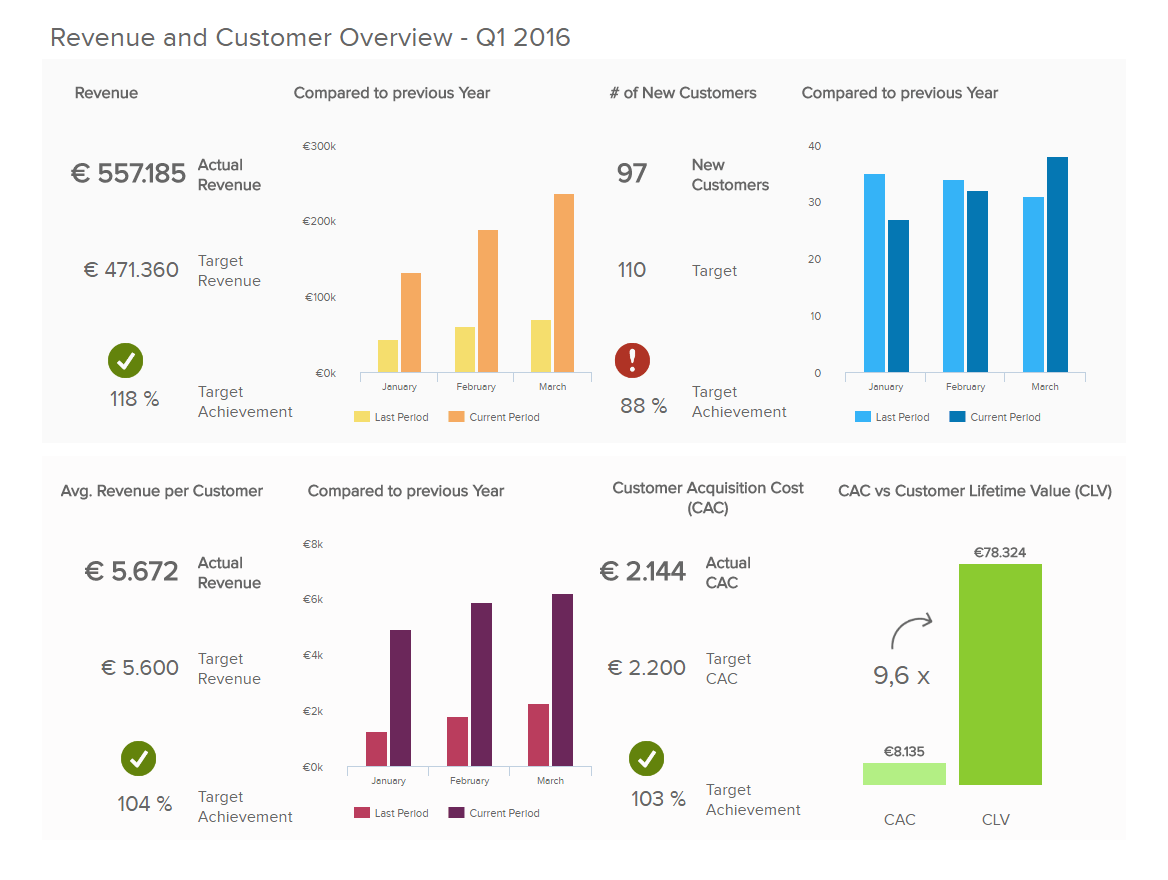
Fundamentally, using data for decision making means working towards key business goals by leveraging verified, analyzed information rather than merely shooting in the dark.
However, to extract genuine value from your information, it must be accurate as well as relevant to your aims. Collecting, extracting, formatting, and analyzing insights for enhanced data driven decision making in business was once an all-encompassing task, which naturally delayed the entire data decision making process.
But today, the development and democratization of business intelligence software empower users without deep-rooted technical expertise to analyze as well as extract useful conclusions from their information. As a direct result, less IT support is required to produce reports, trends, and visualization that facilitate the data decision making process.
From these developments, data science was born (or at least, it evolved in a huge way) – a discipline where hacking skills and statistics meet niche expertise. This fairly new profession involves sifting large amounts of raw data to perform intelligent data driven business decisions.
The ‘gold’ that data scientists ‘mine’ comes in two distinctive types: qualitative and quantitative, and both are critical to making a data driven decision.
Qualitative analysis focuses on data that isn’t defined by numbers or metrics such as interviews, videos, and anecdotes. Qualitative analysis is based on observation rather than measurement. Here, it’s crucial to code the data to ensure that items are grouped together methodically as well as intelligently.
Quantitative analysis focuses on numbers and statistics. The median, standard deviation, and other descriptive stats play a pivotal role here. This type of analysis is measured rather than observed. Both qualitative and quantitative data should be analyzed to achieve smarter business decisions.
Now that we’ve explored the meaning of decision making in business, it’s time to consider the reason why DDDM is important.
Try our powerful data visualization software 14 days for free today!
Why Data Driven Decision Making Is Important?
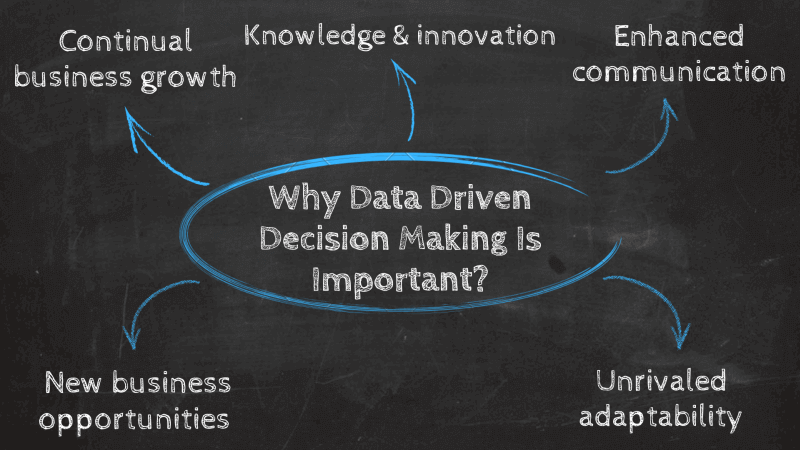

Data based decision making provides businesses with the capabilities to generate real time insights and predictions to optimize their performance. Through this, they can test the success of different strategies and make informed business decisions for sustainable growth.
There are a wealth of reasons that using data to make decisions is a pursuit every modern business should place at the heart of their culture - and we’re going to explore the main points of importance.
1. Continual organizational growth
The core importance of data in decisions lies in consistency and continual growth. Data-driven decision making empowers companies to hone in on key insights based on a multitude of functions, operations, and departmental activities.
One decision after another actioned with consistency will empower you to set actionable benchmarks that result in continual progress and growth - the key ingredients to long-term success in today’s cut-throat digital age.
2. Knowledge & innovation
Data driven business decisions can determine the success of a company. This is a testament to the importance of online data visualization in decision making.
MIT Sloan School of Management professors Andrew McAfee and Erik Brynjolfsson once explained in a Wall Street Journal article that they performed a study in conjunction with the MIT Center for Digital Business. In this study, they discovered that among the companies surveyed, the ones that were primarily data driven benefited from 4% higher productivity as well as 6% higher profits.
Companies that approach decision making collaboratively tend to treat information as a real asset more than companies with other, more ambiguous approaches. Also, when you view digital insights as a genuine asset, you will foster a culture of data driven education - a commercial ecosystem where everyone leverages the power of information to learn more while working to the best of their abilities.
3. New business opportunities
Decision making based on data leads to the discovery of new and exciting business opportunities. Drilling down into accessible visual information will give you a panoramic view of your business's core activities, which, in turn, will ensure you make a series of solid decisions that benefit the commercial evolution of your business.
Armed with the deep-dive insights that will improve your judgment, you will uncover opportunities to expand your growth, create new professional connections, and develop innovations that will give you an all-important edge over the competition.
4. Better communication
Working with a data driven decision management mindset, you will become a better leader - and that will filter down throughout the entire organization.
Whether you’re talking data driven finance, a data driven sales strategy, or any other kind of insight-driven initiative, working with powerful KPIs and visualizations will improve communication across the board.
Operating as one cohesive data driven unit, every one of your departments will gain the ability to share insights with ease and collaborate on key strategies that will ultimately turn you into a more intelligent and profitable business.
5. Unrivaled adaptability
Last but certainly not least, one of the prime benefits of data driven decision making is that it will drive your business to be incredibly adaptable.
By embracing digital data, you stand to grow and evolve your empire over time, making your organization more adaptable as a result. The digital world is in a constant state of flux, and to move with the ever-changing landscape around you, you must leverage data to make more informed and powerful business decisions.
Data driven decision making tools will allow you to connect with emerging trends and patterns that concern not only your internal activities but the industry around you. If you can understand these trends or patterns on a deeper level, you can make informed decisions that will ensure you remain competitive, relevant, and profitable at all times.
5 Successful Data Driven Decision Making Examples
Now that we’ve gained a clearer understanding of what it means to make a data driven decision as well their importance, we’re going to delve into 5 inspiring data driven decision making examples.
1) Google
One of the most notable examples of data driven decision making comes from search colossus Google, according to an article written on smartdatacollective.com. Startups are famous for disbanding hierarchies, and Google was curious as to whether having managers actually mattered.
To answer the question, data scientists at Google looked at performance reviews and employee surveys from the managers’ subordinates (qualitative data). The analysts plotted the information on a graph and determined that managers were generally perceived as good. They went a step further and split the data into the top and bottom quartiles, then ran regressions. These tests showed large differences between the best and worst managers in terms of team productivity, employee happiness, and employee turnover. Good managers make Google more money and create happier employees, but what makes a good manager at Google?
Again, the analysts reviewed data from the “Great Manager Award” scores, in which employees could nominate managers who did an exceptional job. The employees had to provide examples explaining exactly what made the manager so great. Managers from the top and bottom quartiles were also interviewed to round out the data set. Google’s analysis found the top 8 behaviors that made a great manager at Google and the 3 that don’t. They revised their management training, incorporating the new findings, continuing the Great Manager Award and implementing a twice-yearly feedback survey.
2) Walmart
Walmart used a similar process when it came to emergency merchandise in preparation for Hurricane Frances in 2004, as The NY Times reported. Executives wanted to know the types of merchandise they should stock before the storm. Their analysts mined records of past purchases from other Walmart stores under similar conditions, sorting a terabyte of customer history to decide which goods to send to Florida (quantitative data). It turns out that, in times of natural disasters, Americans turn to strawberry Pop-Tarts and beer. Linda M. Dillon, Walmart’s CIO at the time, explained:
“By predicting what’s going to happen, instead of waiting for it to happen… trucks filled with toaster pastries and six-packs were soon speeding down Interstate 95 toward Walmarts in the path of Frances.”
Walmart’s analysts not only kept Floridians pleasantly buzzed on beer and Pop-Tarts during the storm, but also created profits by anticipating demand since most of the products sold quickly.
3) Southwest Airlines
A data driven decision holds an incredible level of value across all industries, but one sector widely-known to benefit from such insights is the airline industry.
Southwest Airlines executives utilized targeted customer data to gain a deeper understanding of what new services would be most popular with customers as well as most profitable.
In doing so, the airline discovered that by observing and analyzing their consumers’ online behaviors and activities, it could provide different segments of customers the best rates for their needs in addition to an exemplary level of customer experience (CX).
As a direct result of this emphasis on data driven decisions, Southwest Airlines has seen its customer base, as well as its brand loyalty, grow steadily year after year.
4) Amazon
Another data driven decision making case study that is wildly discussed in the industry is Amazon. The e-commerce giant uses data from customers' past purchases paired with behavioral analytics techniques to generate accurate product recommendations for users.
These recommendations are implemented across different touch points in the shopping experience from product browsing to checkout, making the process way more personalized and efficient for the user. For example, if a customer bought a mobile phone, Amazon can recommend a phone case at checkout or via email a couple of days after the purchase was made.
By collecting individual data about their customers shopping preferences, Amazon is able to improve the shopping experience and boost sales and revenue in the process.
5) Netflix
With more than 128 million active users, Netflix dominates the streaming service industry thanks to the use of data for customer retention. With the industry becoming more and more competitive by the day, the company needed to find a way to enhance its user experience and make its customers want to stay on the platform.
They did this by carefully studying different metrics related to customer behaviors and interactions such as watch time, date, location, types of shows or movies the user usually watches, as well as when a user pauses or resumes content, and much more. With this information in hand, they manage to generate an accurate recommendation algorithm to enhance the watching experience of the viewer.
After implementing the algorithm, the company analyzed the results and realized that almost 80% of users followed the recommendations. Making it a successful strategy to increase retention rates and stay competitive. An excellent example of successful data-driven decision making.
15 Tips For An Enhanced Data Driven Decision Making Strategy
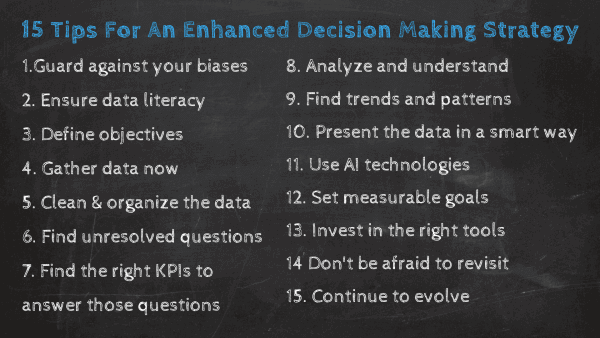

Now that you understand the importance of data-centric decision making, here are 15 practical tips and takeaways for better data based decision making in business. By the end, you’ll be 110% sold on the importance of making these kinds of decisions.
1) Guard against your biases
Much of the mental work we do is unconscious, which makes it difficult to verify the logic we use when we make a decision. We can even be guilty of seeing the data we wish was there instead of what’s really in front of us. This is one of the ways a good team can help. Running your decisions by a competent party who doesn’t share (or even know) your biases is an invaluable step.
Working with a team who knows the data you are working with opens the door to helpful and insightful feedback. Democratizing the analytics process empowers all people, regardless of their technical skills, to access it and carry out informed decisions. Often this is done through innovative dashboard software, visualizing once-complicated tables and graphs in such ways that more people can initiate good data driven business decisions.
With more people understanding the data at play, you’ll have an opportunity to receive more credible feedback. The proof is in the numbers. A 2010 McKinsey study (which is helpful to read even today) of more than 1,000 major business investments showed that when organizations worked at reducing the effect of bias in their decision making processes, they achieved returns up to 7% higher. When it comes to DDDM, reducing bias and letting numbers speak for themselves makes all the difference.
Tips for overcoming a biased behavior
- Simple Awareness – Everyone is biased, but being aware that bias exists can affect your decision making can help limit their impact.
- Collaboration – Your colleagues can help keep you in check since it is easier to see biases in others than in yourself. Bounce decisions off other people and be aware of biased behavior in the boardroom.
- Seeking out Conflicting Information – Ask the right questions to yourself and others to recognize your biases and remove them from your decision process.
By eliminating bias, you open yourself up to discovering more opportunities. Getting rid of preconceived notions and really studying the data can alert you to insights that can truly change your bottom line. Remember, business intelligence shouldn’t only be about avoiding losses, but winning gains.
2) Assess and ensure data literacy
As an extension of the previous point, in order to eliminate all biases and make sure every relevant person can work with data to improve their decision making, it is critical to assess the level of literacy across your organization. While self-service analytics tools make the use of data more accessible and user-friendly, it is still not a given.
In fact, according to Qlik’s latest data literacy survey, only 11% of the surveyed employees are fully confident in their ability to work and communicate with data. This is contrasted with 85% of c-level executives who say data literacy will be “as vital in the future as using a computer is today”.
Taking all this into account, it is clear that the need for a thorough assessment of the levels of data literacy is key to ensuring a successful analytics culture across the organization. Good practice in this regard is to identify employees who are comfortable working with data as they will be able to motivate and help others to learn. Then, you can carry out a survey where you identify issues and knowledge gaps. For example, areas where communication fails due to a lack of analytics knowledge.
Once you know the existing skill gaps you can offer training instances to help employees feel comfortable integrating data into their daily operations. Making sure these changes are applied across all positions and departments, will build a solid foundation for a data-driven organizational culture.
3) Define objectives collaboratively
To get the most out of your data teams, companies should define their objectives before beginning their analysis. When defining your objectives collaboration should not be ignored. Involving all departments in the planning stage can help build more accurate and attainable objectives that align with general company goals. Additionally, involving every relevant stakeholder in the process can also help define roles and responsibilities to build a solid data management foundation.
Set a strategy to avoid following the hype instead of the needs of your business and define clear Key Performance Indicators (KPIs). Although there are various KPI examples you could choose from, don't overdo it and concentrate on the most important ones within your industry. More on this later.
4) Gather data now
Gathering the right information is as crucial as asking the right questions. For smaller businesses or start-ups, data collection should begin on day one. Jack Dorsey, co-creator and founder of Twitter, shared this learning with Stanford. “For the first two years of Twitter’s life, we were flying blind… we’re basing everything on intuition instead of having a good balance between intuition and data… so the first thing I wrote for Square is an admin dashboard. We have a very strong discipline to log everything and measure everything”.
That being said, collecting all the data available to you is not the smartest way to go. Studies suggest that, on average, businesses gather information from a shocking 400 sources. However, just because the data is available to you, it does not mean you have to use it. Using too many sources can make the analysis process confusing and overwhelming. For this reason, defining clear goals and objectives can serve as a perfect guide to choosing only the sources that will inform your strategic plans. In that regard, implementing a business dashboard culture in your company is a key component to properly manage the tidal waves of data you will collect.
5) Clean and organize your data effectively
When it comes to analytics, a fair share of an analyst's time is dedicated to cleaning and organizing the information to make sure that any wrongly formatted data is out before the analysis begins. This is a critical process to perform as the results of your analysis are the basis for a successful data driven strategy and your data needs to be a hundred percent accurate.
With seemingly infinite strings or sets of data to work with, drilling down into the most relevant, valuable insights is the only way to gain clarity and make better decisions. That said, once you’ve gathered your data from your most relevant sources, taking the time to mine for the most business-boosting insights will ensure you can squeeze every last drop of value from your analytical efforts.
When you’re cleaning and organizing your data, you should focus on insights that are:
- Outdated or irrelevant to your specific goals & outcomes (erase)
- Need to be formatted and categorized (arrange)
- Duplicated & creating confusion (erase & arrange)
Streamline the data you’ve gathered, note your most valuable sources, and categorize your cleaned data logically - and you will be on the right path to data-driven success.
6) Find the unresolved questions
Once your strategy and goals are set, you will then have to find the questions in need of an answer, so that you reach these goals. Asking the right data analysis questions helps teams focus on the right data, saving time and money. In the examples earlier in this article, both Walmart and Google had very specific questions, which greatly improved the results. That way, you can focus on the data you really need, and from bluntly collecting everything “just in case” you can move to “collecting this to answer that”.
7) Find the right KPIs to answer those questions
Among the data you have gathered, try to focus on your ideal data, which will help you answer the unresolved questions defined in the previous stage. This information will be later turned into professional key performance indicators. KPIs are invaluable analytical tools used by businesses to answer critical questions and measure the success of their strategic efforts.
There are hundreds of KPIs examples you can use depending on the aim of your analysis. However, as we mentioned previously in the post, just because something can be measured, it doesn’t mean it should be. Many companies make the mistake of using too many KPIs which ends up crowding their dashboards and reports and making their analysis way less productive. To avoid this from happening, make sure you select around 5-8 KPIs that will help you build your data story and make efficient decisions.
8) Analyze and understand
That may seem obvious, but we have to mention it: after setting the frame of all the questions to answer and the data collection, you then need to read through it to extract meaningful insights and analytical reports that will lead you to make data driven business decisions. In fact, user feedback is a useful tool for carrying out more in-depth analyses of the customer experience and extracting actionable insights. To do this successfully, it’s important to have context. For example, if you want to improve conversions in the purchasing funnel, understanding why visitors are dropping off is going to be critical insight. By analyzing the responses in the open comments of your feedback form (within this funnel), you will be able to see why they’re not successful in the checkout and optimize your website accordingly.
9) Find trends and patterns
One of the most integral parts of any effective data baked decision making process is discovering key trends and patterns. After you’ve set actionable goals and conducted some targeted testing in relevant areas of the business, you can drill down further into your newly contextualized data insights and set visual KPIs to uncover any emerging correlations, informational trends, or any patterns that may prove valuable.
For instance, if you’ve set a KPI for visualizing your customer service call resolution rates over a period of a month, and you notice a pattern of resolution rates dwindling (falling below your set target rate) towards the weekend, you will be able to examine the reasons. You might find that staff motivation rates are dropping later in the week - and roll out strategies to boost engagement or inspire motivation based on that discovery.
10) Present the data in a meaningful way
Digging and gleaning insights is nice, but managing to tell your discoveries and convey your message is better. You have to make sure that your acumen doesn’t remain untapped and dusty, and that it will be used for future decision making. With the help of a great data visualization software, you don’t need to be an IT crack to build and customize a powerful online dashboard that will tell your data story and assist you, your team, and your management to make the right data driven business decisions. For example, you need to have your finances under control at all costs:
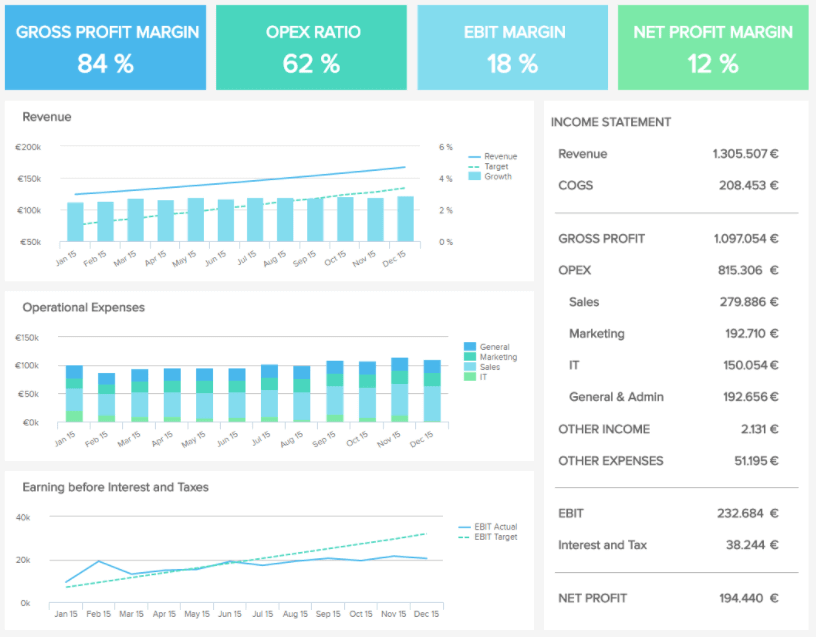
**click to enlarge**
An outline presented on a financial dashboard will ensure an at-a-glance overview of the financial performance of a company. With the top KPIs such as operating expenses ratio, net profit margin, income statement, and earnings before interests and taxes, this dashboard enables a fast decision making process while concentrating on real-time data.
For further inspiration, look at these incredible data visualization examples from some of the world’s most forward-thinking brands and businesses.
Try our powerful data visualization software 14 days for free today!
11) Use AI technologies
71% of key decision makers state that AI technologies have changed their business for the better. By working with platforms driven by artificial intelligence, you will not only boost productivity by eliminating laborious manual analytical tasks but also connect with smarter, more informed decisions faster.
AI data technologies will empower you to gather, collect, organize, present, and engage with your data with maximum efficiency, which, in turn, will accelerate your commercial growth significantly. AI-driven innovations will offer a consistently healthy return on investment (ROI) - which is priceless in the digital age.
Another productivity and ROI-boosting benefit of AI technology, when applied to data, is its ability to automate essential analytic tasks and processes to cut down on manual work and empower users to focus on using their insights to develop innovative strategies that benefit the business. Armed with AI technology, you can also set up intelligent alerts to inform you when you’ve reached a goal, when an event occurs, or when an irregularity arises. This raft of benefits will make your business smarter, swifter, and more responsive to change.
12) Set measurable goals for decision making
After you have your question, your data, your insights, then comes the hard part: decision making. You need to apply the findings you got to the business decisions, but also ensure that your decisions are aligned with the company’s mission and vision, even if the data are contradictory. Set measurable goals to be sure that you are on the right track… and turn data into action!
13) Invest in the right data based decision making tools
When it comes to business analytics for data driven decisions, if you want to realize your goals and make consistently informed decisions, working with the right tools is essential.
We touched on the value of AI technologies - and expanding on that point (as well as the importance of setting measurable goals), working with the right tools will make data accessible to everyone. By gaining access to a centralized dashboard that offers a wealth of digestible data-driven insight, everyone in the business will thrive, resulting in consistent growth, innovation, and profitability. These self-service analytics tools will enable everyone within the business to work with data without prior technical skills - and when everyone can leverage data to their advantage, your business will thrive.
Our cutting-edge BI reporting tool will give everyone within your organization the ability to collaborate effectively while performing to the best of their abilities.
14) Don’t be afraid to revisit and reevaluate
Our brains leap to conclusions and are reluctant to consider alternatives; we are particularly bad at revisiting our first assessments. A friend who is a graphic designer once told me that he would often find himself stuck toward the end of a project. He was committed to the direction he had chosen and did not want to scrap it. He was invested, for the wrong reasons. Without fail, when this happened he would have to start all over again to see the misstep that got him stuck. Invariably, the end product was light-years better reworked than if he had cobbled together a solution from the first draft.
Verifying data and ensuring you are tracking the right metrics can help you step out of your decision patterns. Relying on team members to have a perspective and to share it can help you see the biases. But do not be afraid to step back and to rethink your decisions. It might feel like a defeat for a moment, but to succeed, it’s a necessary step. Understanding where we might have gone wrong and addressing it right away will produce more positive results than if we are to wait and see what happens. The cost of waiting to see what happens is well documented…
15) Continue to evolve your data driven business decisions
This is often overlooked, but it’s incredibly important nonetheless: you should never stop examining, analyzing, and questioning your data driven decisions. In our hyper-connected digital age, we have more access to data than ever before. Make data driven education one of your organization’s key values and encourage a culture where everyone not only improves their own analytical skills but is accountable for testing, exploring, and adapting their business decisions according to the landscape around them.
To extract real value from this wealth of insights, it’s vital to continually refresh and evolve your business goals based on the ever-changing mindsets or preferences of your clients, partners, and consumers.
Data Driven Decision Making Mistakes You Should Avoid At All Costs


At this point, the importance of data in decision making is clear. But while understanding the dynamics of data driven business decisions and exploring real-world examples will steer you in the right direction, understanding what to avoid will help you cement your success.How many times in your life have you prepared for a meeting, had the facts and figures ready to go, and in the end the decision goes the complete opposite direction?
It probably felt like the decision had been made before the meeting even began. If this sounds familiar, you are not alone. We aren’t just talking about a startup full of newbies who think going with their gut is more critical than KPIs; we are talking about huge companies. Rob Enderle, a former IBM employee and Research Fellow for Forrester wrote a fabulous article that documents the shortcomings of executives at IBM and Microsoft.
While the article is packed full of examples, perhaps the most egregious is IBM’s partial sale of its ROLM division to Siemens. Enderle and the team produced an internal report that proved that selling to Siemens would be a catastrophic failure. It turned out that the decision had been made before the research came out. In fact, executives forgot the research had been commissioned at all. Their gut decision ended up costing the company over one billion dollars.
A publication from BI-Survey shows us that 58% of the companies they surveyed said they base at least half of their regular business decisions on gut feel or experience, instead of being data and information-driven. On average, they realized that the companies would use only 50% of the information available when it came to decision-making.
As business intelligence providers ourselves, we understand the importance of DDDM. This is why we’ve created an online data analysis tool that enables clients to get the most out of their data, visualize it in a meaningful way and easily share these generated insights in stunning real-time dashboards to make better business decisions faster. However, the insights we provide are completely useless if, at the end of the day, these reports are ignored by the actual decision makers.
Now that we’ve outlined the foundations of getting your data driven efforts right, we’re going to look into the common problems with that data analysts and businesses might face. By observing and absorbing these key points with the help of data analyst software, you’ll be able to ensure that your process is consistent, results-driven, and centered on your goals at all times.
1) Quality of the data
First and foremost, the main reason usually invoked is data quality. Data quality is the condition of a set of qualitative or quantitative variables, that should be “fit for [its] intended uses in operations, decision making and planning”, according to an article written by author Thomas C. Redmann. A good data quality management (from the acquisition to the maintenance, from the disposition to the distribution processes in place within an organization) is also key in the future use of such data. Collecting and gathering are only good if well managed and exploited afterward, otherwise, the assets’ potential remains untouched and useless.
2) Over-Reliance on past experience
Over-reliance on past experience can kill any business. If you are always looking behind you, there is a real chance of missing what is in front. So often, business leaders are hired because of their previous experiences, but environments and markets change and the same tricks may not work next time. One of the most cited examples of this is Dick Fuld, who saved Lehman after the LTCM crisis. Ten years later he pulled out the same bag of tricks and, as the Wall Street Journal Reports, “the experience he was relying on was not the same as this massive housing-driven collapse.” The recent crisis was much more complex. Environments and markets constantly change and, in order to be a successful manager, one must combine past experiences with current data.
3) Going with your gut and cooking the data
While some managers naturally go with their instinct, there is a significant portion who first trust their gut, then persuade their researchers or an external consultancy to produce reports that confirm the decision that they already made. According to the Enderle article mentioned above, this was commonplace at Microsoft. Researchers were tasked with providing reports that lent credibility to the executives’ decisions.
4) Cognitive biases
Cognitive biases are tendencies to make decisions based on limited information, or on lessons from past experiences that may not be relevant to the current situation. Cognitive bias occurs every day, in some way, in every decision we make. These biases can influence business leaders to ignore solid data and go with their assumptions, instead. Here are a few examples of cognitive biases commonly seen:
- Confirmation bias – Business leaders tend to favor information that confirms the beliefs they already have, right or wrong.
- Cognitive inertia – The inability to adapt to new environmental conditions and stick to old beliefs despite data proving otherwise.
- Group Think – The desire to be part of the group by siding with the majority, regardless of evidence or motives to support.
- Optimism Bias – Making decisions based on the belief that the future will be much better than the past.
Managers need to recognize that we are biased in every situation. There is no such thing as objectivity. The good news is that there are ways to overcome biased behavior. As a result, these businesses identify business opportunities and predict future trends more accurately, generating more revenue and fostering greater growth through data decision making.
5) Failing to set clear goals and objectives
We don’t want to sound like a broken record here, but we can’t stress enough the importance of setting clear goals for efficient data driven decision making. Many businesses fail in the process because they think just gathering the data is enough. However, while having the information available is a key part of the process, it is the organization’s job to put it to good use. And, considering the massive amounts of information being collected, taking the time to define which data will work best to help achieve general company goals is the way to go. In time, this practice also saves invaluable time to make faster strategic moves and stay ahead of competitors.
6) Wrong communication
Failing to implement efficient data storytelling techniques during your decision making process is another common, and very avoidable, mistake. No matter how strong your analytical findings might be, if they don’t come across in the right way, they can be overlooked by high-level decision makers.
Keeping your audience engaged through interactive storytelling can lead to more productive and fructuous discussions. To achieve this, make sure you are using a good mix of visualizations and narrative structure when presenting your findings. Considering the level of literacy of the audience is another good practice. Making sure in advance, that the language used in your storytelling is comprehensible and engaging is also key to success.
7) Not learning from experience
In a perfect world, all your data driven business decisions would be successful. However, this is not always the case, and ignoring bad results can significantly damage your process. To avoid this from happening, make sure you implement a learning process for each of your strategic decisions, positive or negative ones. This will help you understand what could be improved as well as what needs to be replicated in the future.
The important learning here is that, while data analysis software has advanced a lot in the past decades, human intervention is still very necessary to uncover its full potential. If we don’t learn from the information our own data is hiding, it is very likely that your entire analytics journey will be for nothing.
The Role Of Dashboards For Data Driven Decisions
When you have to make a data driven business decision, dashboards may play a crucial role. Having all the historical and current data on a single screen, with the possibility to interact and dig deep into single KPIs or generating an overview of a department or company, dashboards will enable a holistic outline of important information. To see this in practice, we will now take a look at some of the selected examples.
1) Data driven decision for executives management
C-level executives have to stay on top of their data. To be able to efficiently track information based on their strategies and goals, every manager concentrates on the actual revenue generated over a specific time-frame, compared to the target revenue, and with a clear visualization how it has developed (or not), like shown in this example developed with a modern management reporting software:

**click to enlarge**
It also shows the revenue based on customer level, and statistics related to the customer acquisition cost and the total number of new customers acquired. This can help every manager to successfully base their decisions on visualized data, making the process much faster and effective. A testament to why data driven decision making is important in today’s business world.
2) Data driven decision making in retail
In online retail, data collection is quite simple and plentiful. Different ways of shopping, access to reviews and online opinions made consumers more informed than ever. That's why having a clear overview of data is of utmost importance for small business owners, and large enterprises alike. In the example below, we can see how this would look like as an example with selected retail KPIs:
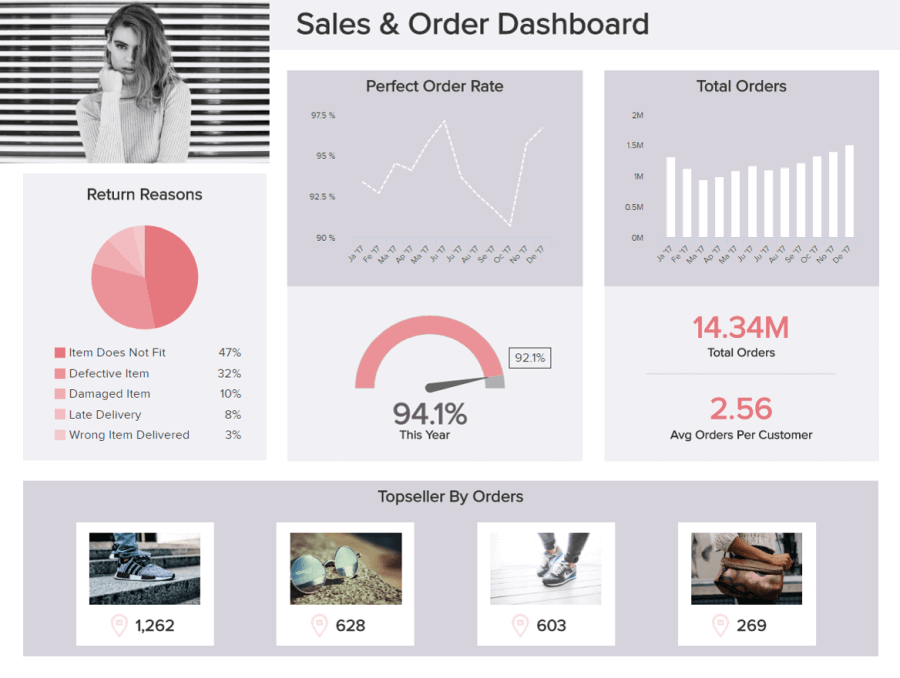
**click to enlarge**
The total amount of orders, the average orders per customer, top sellers, and return reasons stats and figures can give you an overview of the consumers' behavior, why your merchandise is being returned, and which time of the year is your benchmark with the biggest amount of orders. That way you can base your future decision solely based on retail analytics data, and not on a gut feeling that could ruin your business strategy.
3) Data driven decision making in healthcare
The next of our dashboard examples displays powerful key performance indicators in healthcare, a perfect example of how data-driven decision making can enhance patient care and facility management.

**click to enlarge**
Our dynamic healthcare dashboard is a visually balanced hub of information designed to streamline patient care as well as key operational costs. When it comes to healthcare, mistakes or inefficiencies can be a matter of life or death - the stakes are incredibly high.
With three KPIs that offer a wealth of insight on nurse to patient ratios, length of patient stay, readmission rates, treatment costs, and the level of hospital-based infections over set timeframes, this powerful dashboard will ensure that day-to-day medical operations are rolled out with razor-sharp efficiency while improving patient care and reducing unnecessary medical mistakes. An essential tool for any busy medical decision maker.
4) Data driven finance strategy
A visual financial report representing how data drives decision making in finances helps those responsible for the monetary health of an organization to assess and mitigate fluctuating trends and patterns.
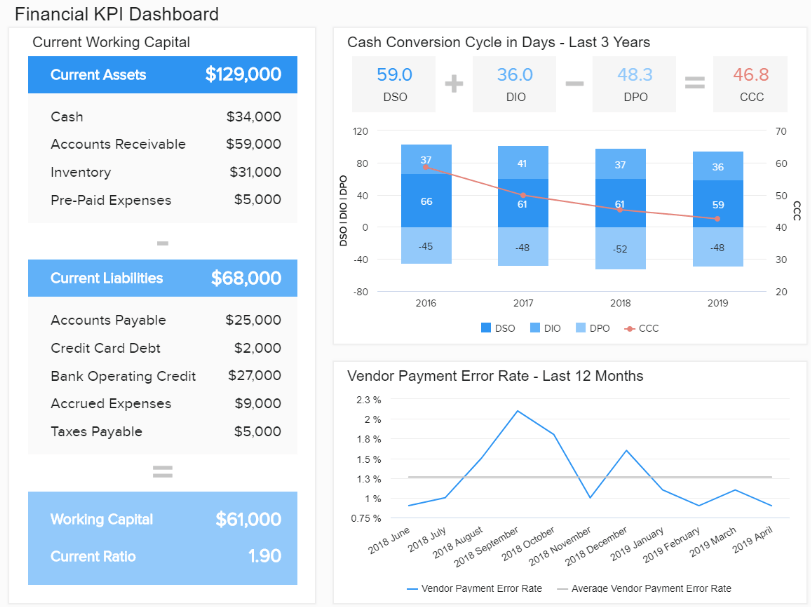
**click to enlarge**
With at-a-glance insights into vital fiscal aspects including working capital, cash conversion cycles, and vendor error rates, here, you can drill down into potential financial inefficiencies swiftly and tackle the issues head-on. Armed with comprehensive information based on your current assets and liabilities, it’s possible to make decisions that affect the fiscal fluency of your organization with pinpoint precision. Working with a financial dashboard of this kind, it’s also possible to manage your external partnerships, including vendors, and remedy any relationships that are draining your business’s efficiency or financial health.
5) Data driven sales strategy
Data driven decision making in business facilitates the development of innovative strategies within various departments - sales is no exception.
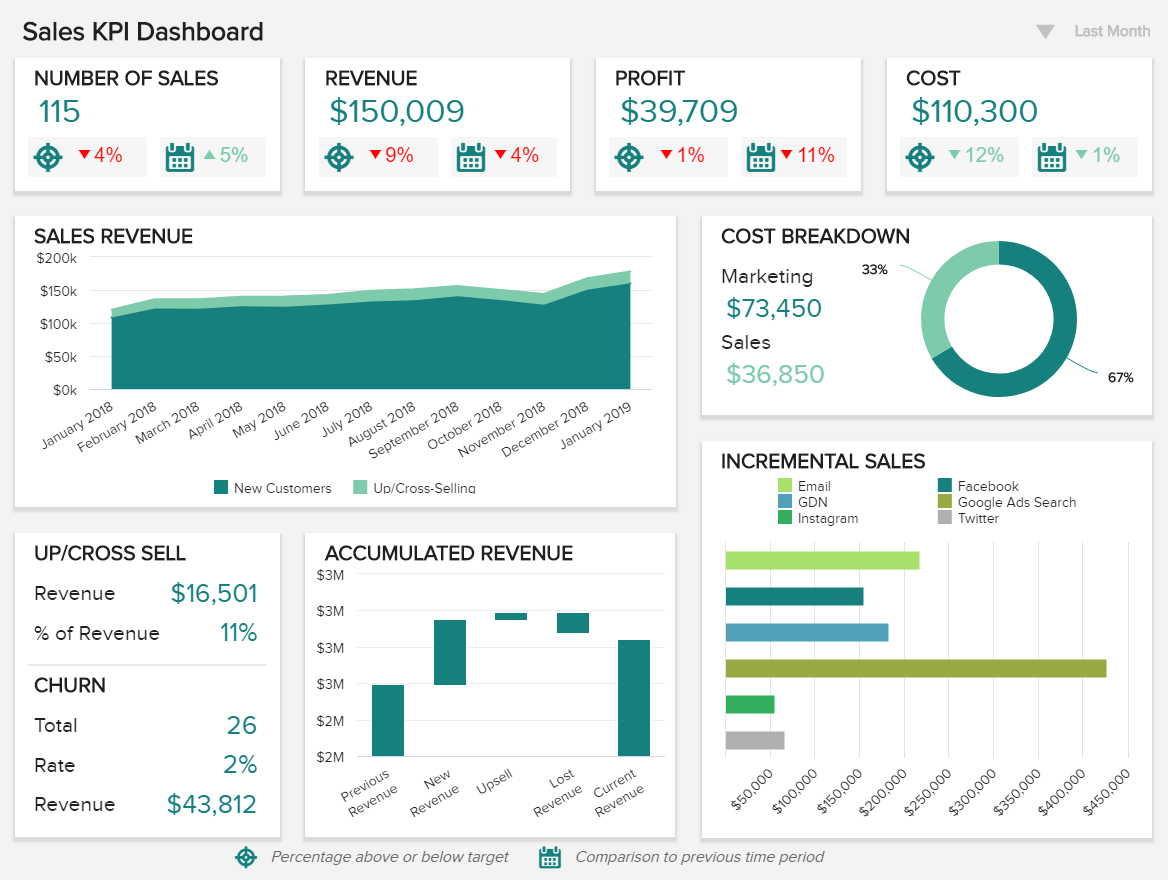
**click to enlarge**
One of the most complete sales dashboard examples, is equipped with all of the data visualizations and KPIs required to optimize upselling or cross-selling initiatives, track incremental sales per channel, break down sales & marketing costs accurately, monitor revenue, and analyze your profits with ease.
Even during your busiest periods, this highly visual dashboard will empower you to make informed, value-driven decisions under pressure. Also, this melting pot of visual insight will allow you to uncover emerging patterns and adjust your sales strategies to engage a wider audience while enjoying a better ROI from all of your prospecting activities.
Try our powerful data visualization software 14 days for free today!
Key Takeaways For Efficient Data Based Decisions
We’ve explored several compelling examples of data driven decision making, and there’s no denying it – by harnessing data in the right way and measuring your success, you stand to propel your business to new and exciting heights.
Now that you have access to all of the key ingredients to make the best data decisions for your business, it’s time to put your plans into action. Remember – for maximum success, you must avoid taking the wrong approach to data driven business decisions at all costs. A failure to do so will lead to making choices with your gut, and biases, or fostering a poor data culture within your organization.
At datapine, we’re 100% committed to helping you make the best data driven decisions for your business. Our solutions combine the very best business reporting software with a cutting-edge perspective toward evaluating your decisions to start seeing results.
To start your own path to successful data driven decisions, visualizing all your data in one place, and generating insights with just a few clicks, you can try our dashboard software for a 14-day trial completely free!